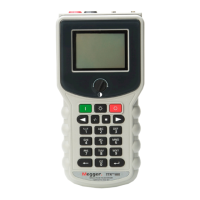AVTMTTR100-ENG Rev 6 Nov 2015
5
2
SAFETY
The TTR100 must be used on de-energized transformers. However, the
transformer to which the test set is connected is a possible source of high-
voltage electrical energy and all persons making or assisting in tests must use all
practical safety precautions to prevent contact with potentially energized parts of
the transformer and related circuits. Persons actually engaged in the test must
stand clear of all parts of the complete high-voltage circuit, including all
connections, unless the test set is de-energized and all parts of the test circuit
are grounded. Persons not directly involved with the work must be kept away
from test activities by suitable barriers, barricades, or warnings.
Treat all terminals of high-voltage power equipment as a potential electric shock
hazard. There is always the possibility of voltages being induced at these
terminals because of proximity to energized high-voltage lines or equipment.
Always disconnect test leads from power equipment before attempting to
disconnect them at the test set. The ground connection must be the first made
and the last removed. Any interruption of the grounding connection can create an
electric shock hazard.
This TTR100 operates from a re-chargeable battery pack. A universal charger,
for re-charging the battery pack, is provided with the instrument. The TTR100
can be utilized while its battery pack is being charged. The universal charger is
equipped with a three-wire power cord and requires a two-pole, three-terminal,
live, neutral, and ground type connector. The voltage to ground from the live pole
of the power source must be within the following rated operating voltage:
100 to 250 V ac single phase, 50/60 Hz 2 Hz
The neutral pole must be at ground potential. Before making connection to the
power source, determine that the charger rating matches the voltage of the
power source and has a suitable two-pole, three-terminal grounding type
connector.
The power input plug must be inserted only into a mating receptacle with a
ground contact. Do not bypass the grounding connection. Any interruption of the
grounding connection can create an electric shock hazard. Determine that the
receptacle is properly wired before inserting the plug.

